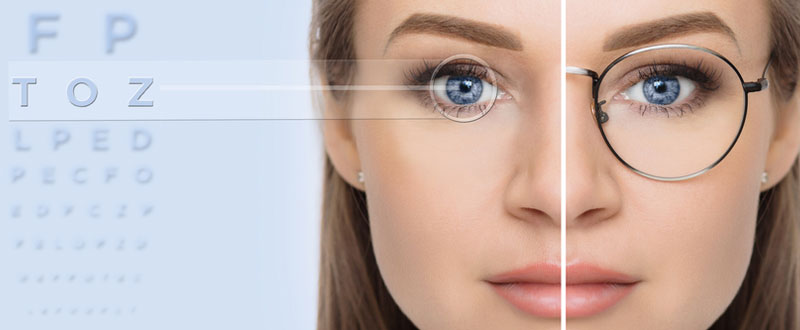Lasik
- Home
- Lasik
A LASIK (laser-assisted in -situ keratomileusis) is a refractive, surgery done to correct vision. It is mainly performed to correct various eye disorders like myopia, hypermetropia and astigmatism. LASIK surgery is performed using a laser which reshapes the eye’s cornea in order to improve accuracy and quality of vision.
Contact lenses do not provide an effective and permanent solution for eye disorders hence LASIK is the common surgery that is performed to correct refractive errors in the eyes. LASIK can be bladeless or done with using blade.

Emmetropia
In Emmetropia condition, absolutely no refractive error exists in person’s vision. Emmetropia refers to an eye that has no visual defects. In an emmetropic eye, a perfectly focused, clear and precise image is formed. When an eye becomes an emmetropic, light rays coming into the eye from a distance come to perfect focus on the retina.
Hypermetropia
Hypermetropia is known as long-sightedness. It is common eye disorder where nearby objects appear blurred but vision is clearer when looking at things further away.
Myopia
Myopia is also known as Nearsightedness. It is a common vision condition in which people can see close objects clearly but objects located far away appear blurred. Myopia occurs if the eyeball becomes too long or the cornea becomes too curved. The exact cause of myopia is still unknown. If one or both the parents are suffering from myopia then there is a higher risk of children developing myopia. A basic eye exam can confirm nearsightedness. People with myopia have many advanced treatment options to regain clear distance vision. Common treatment methods include wearing eyeglasses or contact lenses and Laser procedures like LASIK or PRK.
Lasik Procedure
- First and most importantly, doctor carefully evaluates patient before surgery to ensure that patient is a good candidates for the procedure.
- During the evaluation process, doctor asks about patient’s medical history and does a comprehensive eye examination to evaluate the vision and assess whether patient can undergo the procedure safely or not.
- Ophthalmologist measures cornea, noting the shape, contour, thickness and any irregularities of eye. Then doctor evaluates which areas of the cornea need reshaping and determine the precise amount of tissue to remove from cornea.
- Before starting the LASIK treatment, doctor discusses the risks and benefits of LASIK surgery with the patient and also inform about what to expect before and after surgery as well as clarify patient’s doubts.
- Generally, LASIK surgery takes around 30 minutes or less time. During the procedure, patient lies on back in a reclining chair and numbing drops are placed in the eye then doctor uses an instrument to hold eyelids open.
- A suction ring placed on the eye just before cutting the corneal flap which can cause a sensation of pressure and vision can become a little bit dim.
- Then doctor uses a cutting laser to cut a small hinged flap away from the front of the eye. Folding back the flap allows doctor to access the part of cornea for reshaping.
- Eye doctor reshapes parts of the cornea with the help of highly advanced laser. Each pulse of the laser beam removes tiny amount of corneal tissue. After reshaping the cornea, the doctor lays the flap back into place. The flap usually heals without stitches.
- During the LASIK procedure, doctor asks patient to focus on a point of light. If both the eyes need LASIK surgery then normally doctor performs the procedure on the same day.
- After the LASIK procedure, medication and eye drop is given to the patient to feel comfortable. Regular follow-up appointment with eye doctor is necessary after the procedure.
LASIK ELIGIBILITY
LASIK eye surgery is not suitable for everyone. Doctors do not recommend LASIK surgery for you have certain conditions such as:
- Autoimmune disorders like rheumatoid arthritis
- Weaker immune system caused by immunosuppressive medications or HIV
- Recent changes in vision due to pregnancy, hormonal changes, medications, breast-feeding and age
- Inflammation of the cornea, lid disorders, eye injuries or eye diseases, such as uveitis, herpes simplex affecting the eye area, glaucoma.
Benefits of Lasik
- Improved/enhanced vision
- Higher precision
- Quick results and faster recovery
